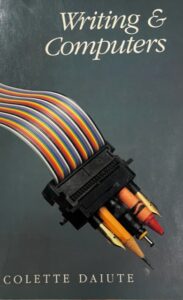Pamela Takayoshi and Cynthia Selfe’s article on approaches multimodal student essays is interesting reading. I have definitely heard these arguments before, and with a lot of the same reasoning behind them. One thing we hear a lot is that communication technologies and styles are moving forward, and we in the English Department need to get with the times. We also hear the student engagement argument – that multimodal assignments are more fun for students, and we can see this in the way they respond. I’m just going to take on these two points and leave the rest for a later discussion.
First, I have been concerned for a while about a kind of vagueness behind the urgency to overhaul our syllabus to replace long, (read: traditional, boring) academic essays with student-produced websites, animated sequences, videos, recordings and the like. Much of it seems to be a reaction to our multimedia environment changing and wanting to be “where the kids are at.” In other words, it’s a kind of fear of our field becoming irrelevant. This fear is evident in the first few sentences of Takayoshi and Selfe’s essay. I found myself asking, what, actually, is the problem with “words on a page, arranged into paragraphs?” Isn’t this exactly the format of the paper Takayoshi and Selfe composed? If writing is not “words on a page, arranged into paragraphs,” what should it be? Or is that kind of (traditional, boring) writing okay for people like Takayoshi and Selfe to master, but not for students at the undergraduate level? If this is true, it leads us to a place where I don’t think we want to be – a two-tiered understanding of who REALLY needs to know how to read and write, and who will be fine if they can just be reasonably fluent in the written discourses accessible to anyone with a social media account.
Speaking for my own teaching, it takes my students more than a semester to learn how to organize their writing into paragraphs. The paragraph is hardly a minor, boring detail, but the organizing principle of long-form text. Of course, if we are arguing that long-form text itself is something we no longer need concern ourselves with teaching, then we can certainly throw the whole idea of “words on a page, organized into paragraphs” to the winds. I have a hard time imagining that math departments debate and struggle so passionately over whether it’s time to rethink “numbers on a page organized into equations,” and whether or not it’s time to move on from it all. This is something that we in the humanities torture ourselves over.
In terms of student engagement, as I put in my text notation on the article, I have had great success with using video and audiovisual content in my composition classes, but I use it as content for students to respond to in their writing. I use it as a way of getting students to think about writing as a form of cultural expression capable of bridging communicative genres, and to empower them to be more articulate critical thinkers: to be able to comment on a wide variety of forms of expression. The result is that they do become engaged in new ways. That, I think is the value of multimedia content in first-year composition. I do not see my approach as offering a diminished place for such content. In fact, it represents a significant shift from what you’d find in the first-year composition classroom even fifteen years ago.
We need not be so thirsty for fun and excitement in our writing classes. Like learning any other skill, sometimes writing isn’t much fun, but we still need to learn how to do it. Finally, student engagement with writing is a difficult thing to see sometimes, because writing is essentially a private activity. We often only find out at the end of the semester how much they’ve really learned, and what it all meant to them – and often it takes them that long, too.





